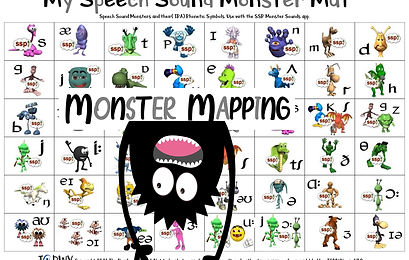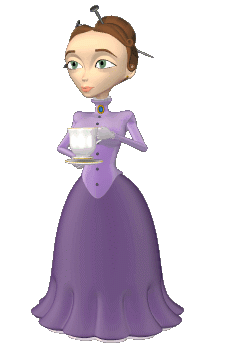
The Speech Sound Pics (SSP) Approach is used to teach reading and spelling in whole class settings across Australia, with fantastic results in Prep/ Reception/ Year1! Explicit and systematic phonics is vital, to kickstart Orthographic Learning, but this SSP Approach is not Synthetic Phonics and so Miss Emma is not launching it in the UK for KS1 as a complete program - until policy changes:-)
Schools can use various activities however, to speed up the rate at which children recognise and blend the commonly used GPCs tested in the Year 1 Phonics Screening Check.
Her obsession is the development of 'orthographic knowledge' via word mapping' - Speech Sound Monster Mapping (phoneme mapping) Code Mapping (phoneme-to-grapheme and grapheme-to-phoneme mapping) Morpheme Mapping (meaningful parts) - leading to Orthographic Mapping (“the mental process we use to permanently store words for immediate, effortless retrieval." Kilpatrick 2015)
Emma Hartnell-Baker is completing doctoral studies at the University of Reading (yes, really) She has a BEd Hons (Early Years Specialism) and Masters Degree in Special Educational Needs, and is passionate about inclusion and 'rethinking differences' (the Neurodiversity Paradigm)
One reason the Speech Sound Pics (SSP) Approach differs from Synthetic Phonics relates to how information is presented within the explicit instruction phase (Phases 1 and 2) and therefore the rate at which constrained skills are learned.
“With frequent repetition, the capacity of consciousness may be increased.”
Hermann Ebbinghaus
Spaced repetition is a powerful technique that helps learners learn and retain information in much less time than it would take otherwise. The idea of spaced repetition is to space out repetitions – or review sessions – so that students are not trying to cram all the knowledge into their brains at once. This is the perfect way to memorise high frequency grapheme to phoneme correspondences for easier recall when reading 'phonics' - code level - readers.
Children learning with the Speech Sound Pics (SSP) Approach learn the 100 or so high frequency GPCs at their pace using the ICRWY Lessons app.
The teacher is simply moving around the room monitoring progress - children learn using the Coding Poster video lesson (5 - 8 mins) and then demonstrate what they have retained (and reinforce prior learning) with the Coding Poster.
Over 90% can pass the PSC before the end of their Reception Year - and decoding code level readers with fluency


4 SSP Code Level Stations. The children just get on - they do not need a teacher there at all as Miss Emma is teaching them on the screen. The Reception teacher can be seen working with children now out of the kick-start 'explicit' phonics phase - those children are in Phase 3 and can now read.




The Speech Sound Pics® Approach!


Use the tools and activities as a catalyst for instructional change. The Speech Sound Pics (SSP) Approach is a unique approach to teaching reading and spelling developed by Emma Hartnell-Baker in Australia almost a decade ago, embracing neurodiversity. Data is both exciting and also humbling. This is not systematic, synthetic phonics however.
Children use 'Duck Hands, Lines and Numbers' to segment and blend speech sounds, and think about the 'pictures' of those speech sounds used when talking on paper. Non-verbal students are able to learn and communicate when the Speech Sound Monsters are included. Differentiation (and having FUN!) is at the heart of its success. Miss Emma created the Speech Sound Pics Approach in Australia to ensure that the needs of neurodivergent learners were being more effectively embraced. She didn't realise quite how many would want to stop her from doing this!
Speech Sound Monsters make phonemes visible, and English orthography more transparent.
'Miss Emma' (Emma Hartnell-Baker) spent a decade in Australia sharing her passion for differentiation using a 'speech to print' approach. She is a hands-on educator who embraces the neurodiverse classroom, including and engaging neurodivergent learners.



"The goal of the model isn’t content knowledge (though it should produce that), but rather something closer to wisdom–learning how to learn, understanding what’s worth understanding, and perhaps most importantly, analyzing the purpose of learning (e.g., personal and social change)."
This is just one of the reasons the Speech Sound Pics (SSP) Approach is different. You will see this in the activities - and especially the 30 Minute Phonics Routine

I am obsessed with ensuring that every child has great phonemic awareness and feels loved and accepted. It's them so much easier for them to
learn to read and spell!
When I started supporting this school I needed
to identify my 'red alerts' ie the children I needed to spend extra time with, to wire their brains, to be 'reading ready'!
Miss Emma x
Embracing Neurodiversity
- Wiring Brains for Thinking and Learning!
Phonemic Awareness, Visual and Linguistic Phonics, Fluency, Vocab Knowledge and Comprehension.

.png)
.jpg)
.jpg)


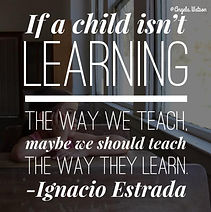
%20-%20Copy.jpg)
Exploring speech sounds, and the way we 'talk on paper'. We are taking pictures of speech sounds with our Magic Speech Sound Cameras - what do they look like in written words? Letters do not 'make sounds' - they represent speech sounds in the written word; which sounds they represent depend on the word! We have fun figuring out the mapping of words! Code Mapping® shows how the words are segmented into graphemes (Speech Sound Pics®) and Monster Mapping® shows how to pronounce each Sound Pic! Speech Sound Monsters make phonemes visible.
We use integrated (embedded) Sound Monsters at all stages of the learning to read and spell journey, for a wide range of reasons.
Words such as 'love' 'come' 'island' 'crumb' asthma' thistle' 'said' 'any' etc are figured out without adult help


.png)
The HUGE difference is HOW phonics is taught which positively impacts on HOW and WHAT the children learn. They are not restricted by 'teacher-led' whole class instruction, because the technology and resources facilitate DIFFERENTIATION and the teacher is a guide.

.jpg)
.jpg)



_Page_30.jpg)
Phonics Teaching Partner


Mary 'following the sounds' after six months of being taught to read using the Speech Sound Pics (SSP) Approach on the Gold Coast in Queensland, Australia - Grade 2 at Broadbeach Independent State School. Mary had faced huge challenges learning to read and write during the first two years of school.
Emma Hartnell-Baker spent a year mentoring lower primary teachers at the school.
Although systematic phonics is essential, if we are to build a foundation of phonics knowledge, Miss Emma has been empowering parents and teachers to focus on orthographic knowledge, leading to orthographic mapping. The Speech Sound Pics Approach has transformed the lives of thousands of Aussie teachers, and their students. Miss Emma hopes to get UK teachers excited about speech & language therapy with orthographic awareness through play too!
The Speech Sound Pics (SSP) Approach includes the 16 essential core criteria published SSP programmes must meet in order to be validated by the DfE however it is more than a synthetic phonics programme, and the teacher is not expected to meet the needs of all children single-handedly. Explicit and implicit learning takes place, with an exploration of the whole code - not just the commonly used phoneme to grapheme correspondences seen in the UK Phonics Screener Check. Over 400 high-frequency words are recognised and spelt correctly within reception, and children explore 'transition' readers alongside phonics / decodable readers.
Over 90% are out of the 'explicit' phonics teaching phase before the middle of Year 1.
Of the three national reports on reading, only England’s Rose Report goes beyond the call for “systematically” taught phonics, by explicitly endorsing “synthetic” phonics, and promoting specific commercial programmes.
The Speech Sound Pics (SSP) Approach to teaching phonics systematically takes a visual and linguistic approach to development of the 'foundation of phonics knowedge' that facilitates 'self-teaching' for all within the neurodiverse classroom.
Although the high-frequency graphemes seen within the UK Letters and Sounds Programme are covered within 4 'Code Levels' and complementary 'decodable readers' are used to support these levels, the children do so at their pace. There is very little 'front of the class' teaching seen within synthetic phonics programmes, with the whole class generally working through the same phonics lessons in the same way and at the same time. Therefore we cannot 'plot' during the year when children will have been taught specific skills and concepts, as this will depend on the learners. We track learner activity. Technology is integral to the Speech Sound Pics (SSP) Approach with regards to the learning of commonly used grapheme to phoneme correspondences (GPCs) Learning the most common grapheme to phoneme correspondences (GPCs) is considered a constrained skill (Pfost, Hattie, Dörfler, & Artelt, 2014)
Teaching GPCs and High Frequency (exception) Words alone (teacher-led) is an ineffective use of teacher time and restricts the teacher's ability to offer a fully differentiated learning experience for all students. They use technology as their teaching partner.
Spaced repetition is used, with children working on the same activity but at their pace. So they learn those skills and concepts when they are ready.
They use the SSP Coding Poster - an indestructible plastic laminate A4 work mat with the 4 Code Levels and first 100 High-Frequency Words. Around 60 - 90 seconds is spent on phonemic awareness using 'Visual Prompts', recognition, pronunciation and writing of code level graphemes, blending of code level graphemes into words, SSP chants, 100 high-frequency words (separated into levels)
and finally, SSP sentence word reading at Code level.
As a result, more children are able to pass the Phonics Screener Check earlier and with more confidence; over 80% will pass before the end of Reception. Our aim is that 95% are reading to learn (have finished explicit phonics instruction) before the end of Year 1.
The A3 Coding Poster can be replaced with the A4 individual Coding Posters in pre-school if they prefer.
These are words Understood.org and many others say ‘can’t be sounded out’. Our pre-schoolers disagree. In fact, they’re so easily ‘sounded out’ when taught Monster Mapping in the very early years they barely have to glance at the words. Spencer is facing the camera!!
They spell them correctly when writing, and recognise them when reading - after very few exposures.
Within synthetic phonics programs these words are often taught as whole words, and the number of words 'taught' is limited - can be as few as 45 in Reception. Speech Sound Pics (SSP) kids cover 200 - 500 - and map them all.
When the kids think of a better rhyme than yours ‘Red frogs, pig and cat, All looked a bit fat’
Lara is reading an SSP Purple Code Level reader that forces the reader to retain meaning in order to keep up with the rhyming, and tests their recognition that the e in ‘landed’ represents the Schwa sound. Regular ‘decodable readers’ don’t tend to push them to do much other than blend known graphemes, page to page. It often means the Schwa-graphemes so frequently seen in ‘real’ texts, are ignored. Lara used the ‘e’ (as in end) sound but then ‘translated’ to ‘landed’ (as she knows the word - vocab knowledge aids this) and so I’d later go back to it and use the monsters on the word to explore every map. However she correctly identified the /er/ Schwa map in ‘after’ (a previously seen high frequency word) Brilliant Purple Code Level work Lara!
Children explore new phoneme-grapheme 'maps' using controlled vocab/ repetitive word readers, alongside Code level readers, at the appropriate time for each learner.
This does not happen within synthetic phonics programmes; only decodable readers are used for independent student reading.
This is limiting (and unnecessary, in light of how brains learn)
Within the Speech Sound Pics (SSP) Approach we guide students to use alternative skills if they cannot decode the unknown words. They are also exposed to more words when they use our technology. Code Mapping shows the segmentation, and Monster Mapping (Speech Sound Pictographs) show them how to pronounce each grapheme in the early stages.
Children also explore new phoneme-grapheme 'maps' within the Speedy Six Spelling.
They use the Speech Sound Clouds to check the maps.
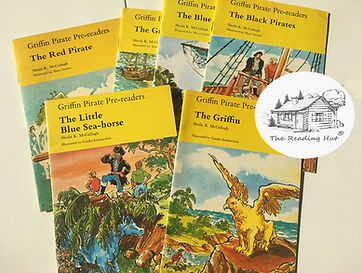
Transition
Readers

Students can start 'levelled' (book band) readers when they reach the end of SSP Yellow Code Level readers, and will read at around a PM Level 10 - 12. However they can start the 1,2,3 and Away and Pirate Stories around the end of SSP Purple, when using the Code Mapped and Monster Mapped versions. These 'Transition Readers' have connected books ie the children not only become familiar with the structure, but also emotionally invested in the characters and story lines.
The grapheme 'h' is used within this decodable reader because we want children to THINK and learn! The word is clearly 'hat' and therefore the children could deduce the sound value of this grapheme (not yet explicitly covered in the teaching sequence) They know the word, so what is the sound value? (ie comprehension to decoding) When this happens in a Code Level reader we use the Speech Sound Detective, to ask children to figure it out. Many would already know this correspondence of course, from parents, pre-school sessions, the television etc! Children do not come to school as empty vessels:-)
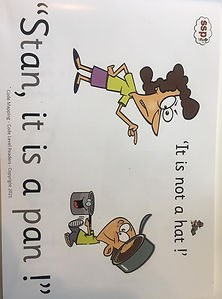


Braintree Forest Readers show farm and forest animals and are being designed to raise an early earth harmony awareness of (sustainable living).
It is difficult to write the earliest (Green Code Level) texts with only s a t p i n and 2 or 3 HFWs but we try to write them with humour!
Within 'synthetic phonics' programs children read decodable readers (with only a limited number of graphemes and high-frequency words) and alternative (authentic) texts are read TO them - eg classic children’s literature. Although they may be exposed to a wide range of text there can be a huge gap between the skills used to decode their own 'readers' and the 'sight word' reading phase in which they are able to read most words without conscious thought. They may crack the basic alphabetic code (with around 100 high-frequency phoneme to grapheme 'correspondences' - a critical starting point for learning to read - however much remains to be acquired beyond this. Orthographic learning is an umbrella term that encompasses both the acquisition of the word-specific knowledge required to access a particular word’s meaning from print and also the accumulation of more general knowledge about orthographic regularities within the writing system. There is much to be learned to move a student from the basic phonic decoding taught within synthetic phonics programmes towards this 'end goal'. The most influential theory of the transition to skilled word reading has been Share’s self-teaching hypothesis, which sets out a theoretical framework (Jorm & Share, 1983; Share, 1995) and provides an experimental paradigm for exploring it (Share, 1999, 2004). Teachers using Code Mapping to explore unfamiliar words will understand the concept. Central to the hypothesis is that exposure is key to this transition, and why Speech Sound Pics (SSP) Approach teachers so happily expose children to words they would be advised to steer clear of when using a synthetic phonics approach, and especially in the early stages. However, exposure to a wide range of texts (with attention to the mapping) provides the dynamic database from which children can accumulate detailed orthographic knowledge, supported by a foundation of alphabetic decoding skill.
As a real teacher, working with real children, and in order to shift the highest number of children from phonics decoding of 'regular' words to sight word reading we use 'Transition Readers' to EXPLICITLY and SYSTEMATICALLY bridge the gap and guide learners into the Orthographic Mapping phase as quickly and easily as possible (before the end of Year 1
The single most effective pathway to fluent word reading is print experience: students need to see as many words as possible, as frequently as possible. Teachers can seek to provide as much exposure to print as they can during classroom activities but what they can achieve will be minuscule compared with the exposure that children can attain for themselves during their independent reading. This is why we aim to ensure that 95% of children are reading authentic texts of their choice before they enter grade 2, including those with dyslexia. We could not do this by limiting our teaching to the DfE's current 'recommendations'- too much is missing.

